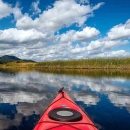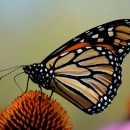Re • sil • ience (n): an ability to recover from or adjust easily to misfortune or change
In a word, resilience is toughness. Coastal resilience is the capacity of ocean shorelines to adapt to and resist the effects of climate change climate change
Climate change includes both global warming driven by human-induced emissions of greenhouse gases and the resulting large-scale shifts in weather patterns. Though there have been previous periods of climatic change, since the mid-20th century humans have had an unprecedented impact on Earth's climate system and caused change on a global scale.
Learn more about climate change , including more-frequent intense storms and sea-level rise, so human and wildlife communities can continue to thrive.
Coastal resilience means shorelines can absorb and rebound from flooding and destructive waves. By building resilient coasts, we can restore habitat for wildlife and protect human infrastructure. Salt marshes and barrier beaches are nature’s way of ensuring that ecosystems are resilient to coastal flooding.
In our Northeast Region, federal funding following Hurricane Sandy launched landscape-scale resilience projects up and down the Atlantic Coast.
Since the storm, we have bolstered coastal resilience by restoring marshes, beaches and rivers so they function as nature intended, and our work continues. Coastal resilience looks like:
- healthy, absorbent marsh systems that soak up storm surge and offer habitat for wildlife like the saltmarsh sparrow, whose numbers are declining
- dynamic, deep beaches that move with the tides, creating a buffer for coastal communities and giving shorebirds like the piping plover places to nest
- free-flowing rivers, without derelict dams, that reduce flooding while allowing migratory fish to reach historic breeding grounds
- offshore oyster reefs or living shorelines that dampen wave energy and buffer beaches from erosion while providing habitat for not only oysters but mussels, crabs and young fish
Intact beaches and sand dunes, healthy salt marshes and free-flowing rivers offer front-line defense against sea-level rise and more-frequent severe storms. Incorporating nature-based solutions like these protects houses and neighborhoods from the worst of coastal threats, while improving habitat for important coastal wildlife species.
Protecting people, protecting wildlife
Saltmarsh sparrow:
Saltmarsh sparrows are the picture of resilience: When high tides wash out their nests, the birds quickly bounce back and rebuild. They rise to the challenges nature throws at them. But, with climate change, those challenges are getting larger and harder to surmount. Rising sea levels mean the sparrows' high-marsh habitat is more susceptible to irregular, frequent flooding, and sparrows don't have time to fledge their chicks between monthly ultra-high tides.
Investing in coastal resilience means investing in the sparrows and the communities surrounding the salt marsh salt marsh
Salt marshes are found in tidal areas near the coast, where freshwater mixes with saltwater.
Learn more about salt marsh . Saltmarsh sparrows are often regarded as a "canary in the coal mine”; they are the first to react to dips in marsh health, a signal to biologists and land managers that the system is hurting. Saltmarsh sparrows and their recovery are deeply intertwined with coastal resilience work. When we reinforce healthy, absorbent marsh systems that help protect coastal communities from storm surge and water pollution, we support saltmarsh sparrow habitat and the health of this struggling population.
Piping plover; rufa red knot:
Piping plovers are also central to the coastal resilience conversation: They thrive on sandy, open beaches. When beaches are dynamic and able to move as tides push sand in and out, coastal communities are protected from the worst of storm surge, and plover habitat thrives. Bolstering coasts with concrete seawalls or building high-rise complexes right up to the beach prevents beaches from moving with the tides and often leaves communities vulnerable to the worst of storm surge. It also leaves the threatened piping plover even less space to nest, in habitat already full of dangers like dogs and vehicles rolling down open beach. When we invest in dynamic, healthy shorelines that are resilient to storm surge, we are also investing in habitat that benefits this celebrated species.
Sometimes, the best way to bolster resilient coastlines is to protect them from the intensity of waves altogether. Humans have built concrete seawalls and stone riprap to protect coastlines from intense wave action for centuries. These structures can hinder ecological processes and degrade over time. Living shorelines — offshore structures made of interlocking concrete blocks supplemented with bags of shells — dampen wave action and reduce shoreline erosion while allowing wildlife like horseshoe crabs to reach the shore. The rufa red knot, a threatened shorebird, refuels on the crabs’ eggs during migration north. When we follow nature’s patterns to build infrastructure like living shorelines, we can instill coastal resilience for the people and wildlife who call the coast home.
River herring:
When dams — many built long ago for now-obsolete industrial uses — or undersized culverts obstruct rivers, they block the upstream journey of migratory aquatic species. River herring — alewife and blueback herring — are economically and ecologically important fish at risk of steep population declines. They bring nutrients from the sea back upstream, completing the nutrient cycle, and are prey for everything from bald eagles to striped bass. Local communities benefit from their recreational and commercial use. Obstructing their waterways only further strains these valuable and vulnerable populations.
Obstructed waterways threaten humans, too. In recent years, intense storms have highlighted threats to people and property posed by aging dams that fail and outmoded culverts overwhelmed by heavy floodwaters. In addition to improving passage for wildlife like river herring, removing or upgrading these structures can benefit public safety — and, in some cases, quality of life — through improved amenities.
The path to a stronger coast
Not your typical storm
In our Northeast Region, federal funding following Hurricane Sandy launched landscape-scale resilience projects up and down the Atlantic Coast.
Hurricane Sandy made landfall on Oct. 29, 2012, near Brigantine, New Jersey, devastating communities along the Atlantic Coast. Record levels of storm surge were recorded in New Jersey, New York and Connecticut, with tropical storm-force winds covering an area about 1,000 miles wide. Wind, rain and surf from the “superstorm” led to 150 deaths and more than $65 billion in damages.
In addition to extensive loss of life, livelihood and property, the region's national wildlife refuges were greatly impacted. Rain washed out roads, dunes and dikes. Storm surge left miles of debris and hazardous materials on beaches and in coastal marshes and forests. High winds damaged buildings and caused power outages. Refuges suffered loss of habitat, staff productivity and visitor opportunities.
A legacy for wildlife and people
Hurricane Sandy left a legacy of more-resilient wildlife habitat and increased community safety along the Atlantic Coast. It signaled what a future of climate change might look like if we fail to plan and adapt by working with nature.
Following the storm, our Northeast Region invested $103 million of federal funding to complete more than 30 resilience projects. Through this,182,000 acres of marsh were protected, strengthened, and restored; 200 miles of river restored and bolstered; and nearly seven miles of living shoreline constructed.
In addition to on-the-ground conservation efforts, Sandy funding supported socioeconomic and ecological assessments for dozens of marsh restoration, aquatic connectivity and coastal erosion projects across the Atlantic Coast, as well as regionwide wildlife and habitat studies to guide management decisions and actions.
Sandy investments collectively have advanced the science of resilience, supporting ongoing research and monitoring across the Northeast to help us learn and adapt, change as conditions change and work with nature to build a stronger coast.
Accomplishments after the storm:
- More than a dozen dams removed or evaluated for removal in 4 states
- Nearly 200 miles of stream restored for fish passage fish passage
Fish passage is the ability of fish or other aquatic species to move freely throughout their life to find food, reproduce, and complete their natural migration cycles. Millions of barriers to fish passage across the country are fragmenting habitat and leading to species declines. The U.S. Fish and Wildlife Service's National Fish Passage Program is working to reconnect watersheds to benefit both wildlife and people.
Learn more about fish passage - More than 150 miles of coastline restored and cleared of debris
- Nearly 7 miles of living shoreline constructed in 2 states
- 1,364,000 acres mapped for Coastal Barrier Resources Act
Learn more about our coastal resilience work in some of our stories:
- Listen: A conversation on the legacy — and future — of Hurricane Sandy: Sitting down with Rick Bennett
- A New Natural Normal: Nearly a decade after Hurricane Sandy, a stronger coast benefits wildlife and people in a changing climate
- Looking to the future by commemorating the past: A Prime model of coastal resilience long after Hurricane Sandy
- Building a legacy of resilience for future challenges: Rick Bennett championed forward-thinking restoration 10 years ago. Today it's paying off.
- Prime Hook and the power of planning ahead: Susan Guiteras sees the long pay-off of preparing for climate change
- A decade out from Sandy, Pond Lily stands as a reminder of resilience and the power of letting nature lead









